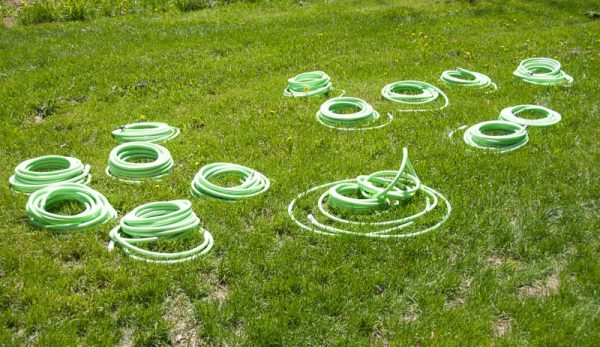
Times change. Situations shift. What worked one year might not work the next. This applies to many things in life, including things as obscure as watering raised garden beds in an orchard.
When I started planting a new orchard in 2018, I invested in a 35-gallon leg tank to haul water to my trees. The front of the orchard is about 600 feet from the nearest water source. The back of the orchard is nearly 1,100 feet away, so a gravity-fed leg tank filled in the barnyard and hauled by tractor to the orchard seemed like the simplest way to care for the large handful of trees I’d planted.
Read more: Water your orchard effectively with a 35-gallon leg tank.
Where a 35-gallon leg tank once met my orchard’s watering needs, I now find it’s more effective to use a dozen hoses to water my plants. There’s a lesson in that for farmers.
Changes to the Farm
Indeed, it worked fine for several years. But as I expanded the number of trees in the orchard (and added a couple of raised garden beds for growing pumpkins … and a couple more for growing corn … and then four more beyond that for raspberries and sunflowers and more corn) the 35-gallon leg tank grew insufficient for my needs.
In 2022, most of my trees were established to the point where they didn’t require regular watering beyond the rainfall they receive. But with a bevy of garden beds to care for, the 35-gallon leg tank simply didn’t offer enough capacity. I often found myself making multiple trips to provide enough water during the hot peak of summer. Between filling the tank, driving it to the orchard, slowly dispensing the water by gravity, and driving it back to repeat the process, watering my garden beds became a very time-consuming project.
A Different Approach
That’s why I’m changing up my strategy for 2023. Rather than haul water in a leg tank, I’ve purchased enough hoses to stretch across my farm from a yard hydrant to the garden beds. That’s right—I’ve invested in 625 feet of hoses to go along with the 50-foot hose on my leg tank. When I compared prices across suitable hoses, 50-foot versions were the cheapest. So I bought a dozen of those (that’s all the seller had available) and picked up one 25-footer for good measure, adding up to 625 feet.
You might be wondering about water pressure over such a lengthy distance. Well, the elevation of the yard hydrant is about 15 feet higher than the garden beds, so the downhill slope to the garden beds helps keep water pressure suitable. I tested this last fall using a bunch of other hoses from around the farm. The water pressure at the end is better than I get from the gravity-fed leg tank, so that should work out fine.
Read more: Read some key takeaways one hobby farmer learned from two years of growing corn.
Evaluate the Upsides
Purchasing 625 feet of hoses is more expensive than picking up another 35-gallon leg tank, which is another option I considered. But the upsides are considerable.
I’ll save time by not filling leg tanks and by dispensing a higher volume of water faster with the hoses. Just as importantly, I can water my beds thoroughly during the heat of summer, without having to drive leg tanks back for refills. That may lead to increased yields.
I’ll still use my 35-gallon leg tank for watering trees throughout the orchard, since it works very well for that purpose. But for thirsty corn and pumpkin plants, my new hoses are the perfect solution for changing times and shifting situations.
There’s a lesson to be learned here. Just because an approach worked for a while doesn’t mean it’s the perfect approach forever and always. Frequently reevaluating your situations and needs can save you time and lead to better results, as my hoses-versus-leg-tank example illustrations.




